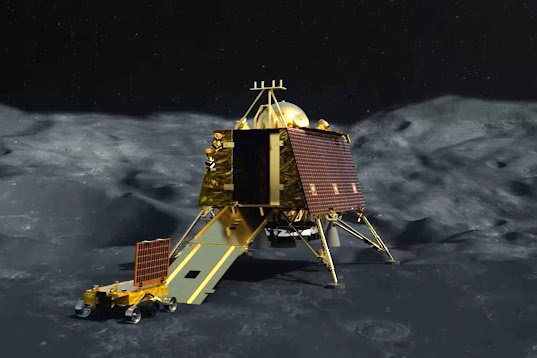By successfully bringing its Chandrayaan-3 spacecraft close
to the Moon's south pole on August 23, 2023, India has accomplished a
tremendous milestone in space research. This location, which is regarded as one
of the trickiest and most fascinating places on the lunar surface, has never
had a spacecraft land there before.
The Indian Space Research Organization (ISRO), whose name
means "mooncraft" in Sanskrit, has launched Chandrayaan-3, its third
lunar mission, as part of the Chandrayaan program. Similar to the Chandrayaan-2
mission, which failed to land on the moon in 2019 due to a lack of
communication during the final descent, the mission comprises of a lander named
Vikram and a rover named Pragyan. 34
Launch Vehicle Mark-3 (LVM3) rocket powered the launch of
the Chandrayaan-3 spacecraft on July 14, 2023, from the Satish Dhawan Space
Centre in Sriharikota, India. when many orbital maneuvers, the lander detached
from the propulsion module on August 2 when the spacecraft entered lunar orbit
on August 5. On August 23, at 12:32 UTC, the lander carried out a powered
descent before touching down close to the south pole of the moon, creating
Indian and global history.
Between the craters Manzinus C and Simpelius N, in a
latitude of roughly 69 degrees south and a longitude of roughly 32 degrees
east, is where Chandrayaan-3 will land. The neighboring mountains provide a
perpetual shadow over this region, which is of significant scientific interest
since it might have water ice and other volatile deposits that are beneficial
for future exploration and habitation.
The lander has already sent back some pictures of the lunar
surface, which depict a cratered and rough topography. A laser retroreflector
array (LRA), radio anatomy of the moon-bound hypersensitive ionosphere and
atmosphere (RAMBHA), an instrument for lunar seismic activity (ILSA), and Chandra's surface thermo-physical experiment (ChaSTE) are the four scientific
instruments on board the lander. These devices will measure the lunar soil's
thermal conductivity, seismic activity, reflectance, and surface temperature.
In a short while, the lander's internal rover will emerge
from its belly and begin exploring the area. The six-wheeled rover can move
away from the lander up to 500 meters and weighs roughly 26 kg. The rover is
equipped with two scientific tools: a laser-induced breakdown spectroscope
(LIBS) and an alpha particle X-ray spectrometer (APXS). The lunar rocks and
soil's chemical makeup and mineralogy will be examined using this equipment.
Additionally, the rover will use its cameras to take high-definition pictures
and films of the lunar surface.
The projected operating time of the lander and rover is 14
days or one lunar day. Through the propulsion module, which is still circling
the moon, they will communicate with one another and with Earth throughout this
time. The lander and rover's acquired data will be sent to ISRO's mission
control center in Bengaluru, India, where researchers will analyze it and share
it with the world's scientists.
Chandrayaan-3's achievement is proof of India's ingenuity
and technological strength in space. It also highlights India's dedication to
increasing humankind's understanding of science and opening up new horizons.
According to Prime Minister Narendra Modi, "India is now on the moon"
and "the sky is not the limit" as he congratulated ISRO and the
country on this historic accomplishment. He added that in order to realize the
dream of a developed India by 2047, Chandrayaan-3's excitement must be used to
inspire young people's scientific minds.
Chandrayaan-3 is a significant development for international
cooperation in space exploration as well as a proud moment for India. India has
collaborated with several countries and agencies for this mission, such as
NASA, ESA, JAXA, CNES, ROSCOSMOS, KARI, ASI, UKSA, CSA, DLR, NSO, NSC,
DST-South Africa, AEB-Brazil, CONAE-Argentina, SUPARCO-Pakistan, SANSA-South
Africa, SSAU-Ukraine, SSO-Switzerland, SSC-Sweden, KACST-Saudi Arabia, and the
UAE Space Agency.
With Chandrayaan-3, India joins the US, the Soviet Union,
and China as the only other nations to have successfully landed a spacecraft on
the Moon. Additionally, India became the first nation to set foot close to the
lunar south pole, creating new opportunities and difficulties for lunar exploration.
The astounding accomplishment of Chandrayaan-3 will serve as an example for
future generations and enhance both science and humanity.





Post a Comment